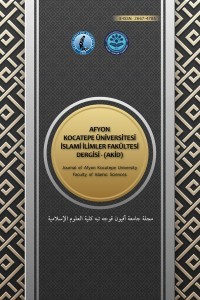
Kocatepe İslami İlimler Dergisi
Yazarlar: ["Süleyman ABANOZ"]
Konular:-
DOI:10.52637/kiid.1239566
Anahtar Kelimeler:Din psikolojisi,Halk dindarlığı,Ziyaret dindarlığı,Hacı Bayram-ı Veli,Türbe
Özet: As a special form of Turkish folk religiosity visiting shrines emerge as a multifaceted religious, mystical, magical belief and sociocultural phenomenon throughout history and today. Visiting shrines constitutes a very important aspect of the culture and religion of the society. The places where people with prominent religious and spiritual aspects are buried continue to be the subject of visits for various wishes and purposes due to the spiritual virtues they are believed to have. Shrines are at the forefront of these places visited for religious purposes. The visits to the shrines basically have two purposes: Realizing some wishes and experiencing the spiritual environment here. Visits made with the expectation that a wish will come true are more than others. In the requests made in the shrines, issues such as having a child, having a son, having a job, getting married, finding a good fortune for the child, getting rid of the disease, owning a house-car and getting rid of psychological problems come to the fore. In this study, the phenomenological analysis model included in the qualitative paradigm was used. Thus, it is aimed to evaluate the visit phenomenon in terms of visitors. The study group of the research consists of those who visit the shrine of Haji Bayram Wali. In this context, interviews were conducted with 47 people. Descriptive analysis technique was preferred in the evaluation of the data obtained through the interview. While some shrines are identified with some special requests, it is understood that the shrine of Haji Bayram Wali is a shrine for all kinds of requests. Some participants state that they visit various shrines whenever they can, while others state that they come to Haji Bayram regularly. The most common practice in the shrine of Haji Bayram Wali is to pray in the mosque adjacent to the shrine and to pray by reading the Qur'an in the shrine. Foods such as chocolate, Turkish delight and sweets are often distributed around the shrine by the visitors. Apart from this, different applications such as inserting a key into the lock of the shrine also have been witnessed. The shrine is visited by visitors of all ages and occupations, from different educational and socioeconomic levels. Due to the fact that there are officials walking around frequently and the shrine is in an area that can be seen by everyone, activities such as rag binding, and taking soil from the shrine which are not tolerated in Islam or accepted as bid’ah are not carried out much. In addition, many of the participants said that they did not expect help from the person buried in the shrine directly, and that they hoped that their wishes would be realized by Allah thanks to the respect and love they felt for Haji Bayram and in honor of his sake. Although little is known about the life of Haji Bayram, it is widely believed that he was a saint and that the prayers made in his shrine would be accepted. Most visitors come to the shrine on fridays. The number of visitors is increasing when the belief that the prayers made in the shrine will be more accepted, combined with the expectation that the prayers made on friday will be more accepted. In addition, more treats are distributed on fridays, so this day is preferred for those who want to both distribute charity and receive treats. On some fridays, an old man with a long beard, dressed in a turban and robe, who looks like a religious figure sits near the shrine and prays for the people who come to him and gives advice is one of the factors that make people come here. Whether it is seen as a bid'ah, superstition or an innocent manifestation of folk piety, the shrine meets the visitors' search for a spiritual environment, increases the expectation that their prayers will be accepted, and provides many psychosocial contributions to the visitors. As long as it maintains these characteristics, it can be said that people will continue to come here.